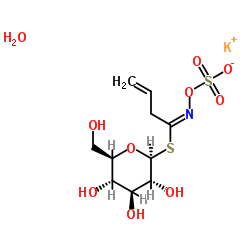Interactive effects of sulfur and nitrogen supply on the concentration of sinigrin and allyl isothiocyanate in Indian mustard (Brassica juncea L.).
Jóska Gerendás, Jana Podestát, Thorsten Stahl, Kerstin Kübler, Hans Brückner, Volker Mersch-Sundermann, Karl H Mühling
Index: J. Agric. Food Chem. 57(9) , 3837-44, (2009)
Full Text: HTML
Abstract
Food derived from Brassica species is rich in glucosinolates. Hydrolysis of these compounds by myrosinase yields isothiocyanates and other breakdown products, which due to their pungency represent the primary purpose of Indian mustard cultivation. Strong interactive effects of S (0.0, 0.2, and 0.6 g pot(-1)) and N (1, 2, and 4 g pot(-1)) supply on growth, seed yield, and the concentrations of glucosinolates and isothiocyanates in seeds were observed in growth experiments, reflecting the involvement of S-containing amino acids in both protein and glucosinolate synthesis. At intermediate S supply, a strong N-induced S limitation was apparent, resulting in high concentrations of sinigrin (12 micromol g(-1) of DM) and allyl isothiocyanate (213 micromol kg(-1) of DM) at low N supply only. Myrosinase activity in seeds increased under low N and low S supply, but the results do not suggest that sinigrin functions as a transient reservoir for S.
Related Compounds
| Structure | Name/CAS No. | Molecular Formula | Articles |
|---|---|---|---|
 |
Sinigrin
CAS:3952-98-5 |
C10H16KNO9S2 |
|
Multidirectional time-dependent effect of sinigrin and allyl...
2010-09-01 [Plant Foods Hum. Nutr. 65(3) , 217-24, (2010)] |
|
Allyl isothiocyanate-rich mustard seed powder inhibits bladd...
2010-12-01 [Carcinogenesis 31(12) , 2105-10, (2010)] |
|
Determination of sinigrin in vegetable seeds by online micro...
2010-04-28 [J. Agric. Food Chem. 58(8) , 4571-5, (2010)] |
|
Influence of NaCl and NaNO3 on sinigrin hydrolysis by foodbo...
2011-12-01 [J. Food Prot. 74(12) , 2162-8, (2011)] |
|
Updated glucosinolate profile of Dithyrea wislizenii.
2009-05-22 [J. Nat. Prod. 72(5) , 889-93, (2009)] |